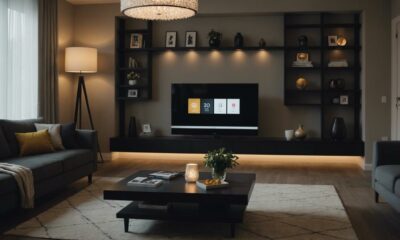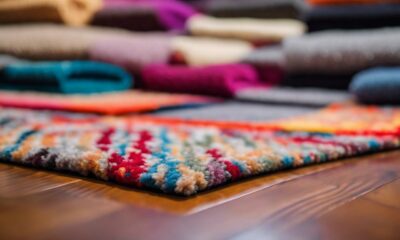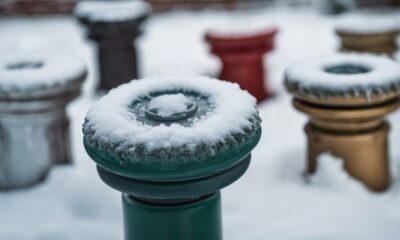Wall Art and Decor
How Much Do I Charge to Paint Interior of House
Mull over factors like room size and surface type to determine how much to charge for painting the interior of a house – the key to fair pricing awaits!
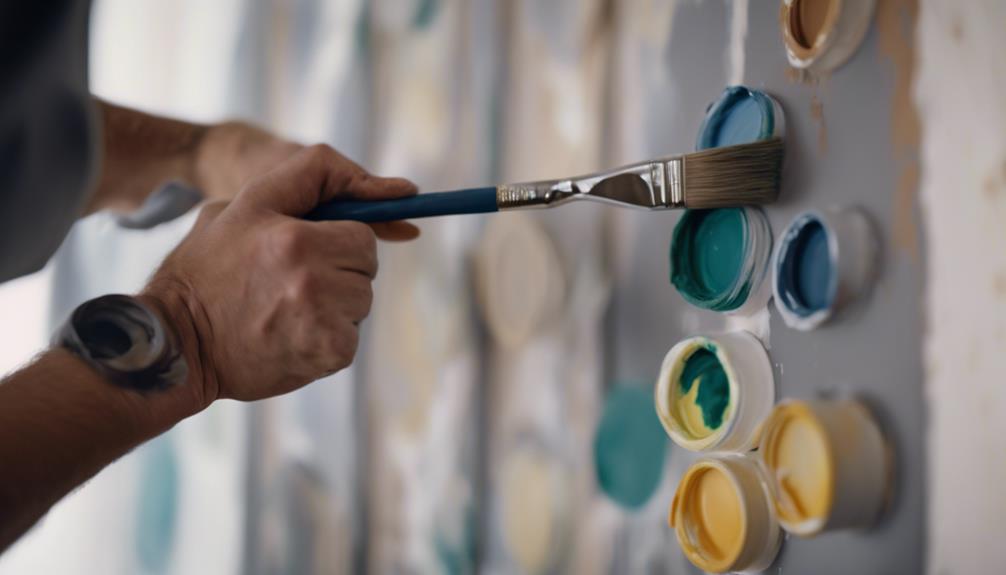
When deciding how much to charge for painting the interior of a house, take into account factors such as room size and surface type, which can greatly affect the total cost. Prices vary depending on the room: bedrooms usually range from $375 to $800, while living rooms can cost between $600 and $2,000. Square footage pricing typically falls between $3 to $7 per square foot. Additional services like high ceilings or wall repairs can raise the overall cost. Have a clear plan in mind before setting your price, ensuring accuracy and fair compensation. Explore further for detailed insights into pricing considerations.
Key Takeaways
- Consider square footage pricing between $3 to $7 per sq ft.
- Factor in additional costs like high ceilings or wall repairs.
- Determine labor rates and quality of paint for accurate pricing.
- Estimate materials needed such as brushes and drop cloths.
- Compare DIY costs starting at $300 to professional costs up to $28,000.
Average Cost to Paint by Room Size
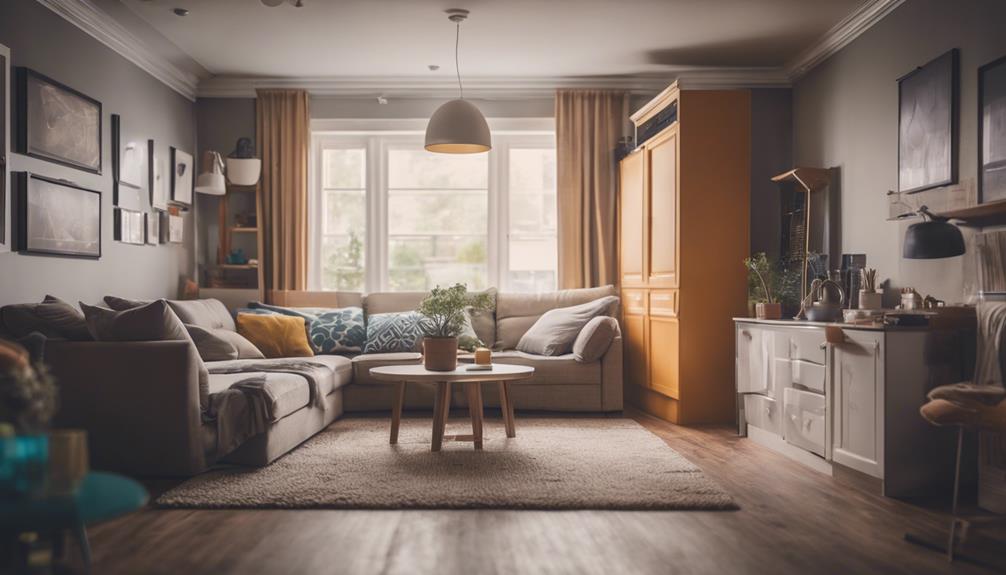
When considering the average cost to paint by room size, it's important to note the varying price ranges depending on the specific room you're looking to paint.
Painting an interior room in your home can come with different costs. For example, to paint a bedroom professionally, you might expect to pay between $375 to $800.
If you're looking to freshen up your living room with a new coat of paint, the average cost ranges from $600 to $2,000.
Bathrooms can be painted for approximately $200 to $600, while kitchens may cost $600 to $1,000 for painting services.
Dining rooms, on the other hand, have an average painting cost of $400 to $800.
These costs can vary based on the size of the room, the quality of paint chosen, and any additional services you may require from a professional painter.
Interior Painting Cost Factors
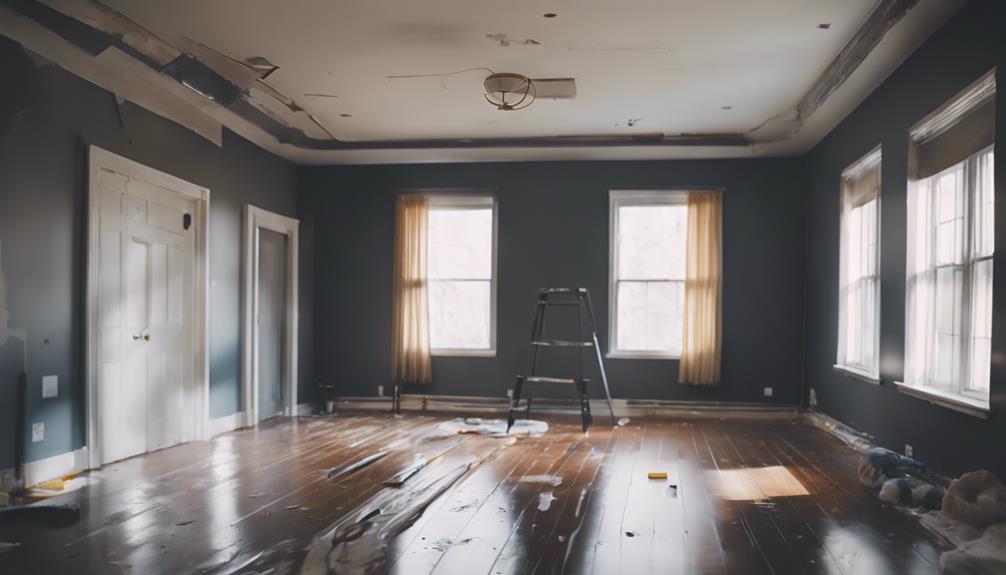
Curious about the factors that influence the cost of interior painting? When determining the cost of painting the interior of your house, several key elements come into play. The square footage of the area to be painted is a significant factor, with prices typically ranging from $3 to $7 per square foot. However, certain aspects such as high ceilings, extensive wall repairs, or specific features can push the cost up to $8 or more per square foot. Labor rates, quality of paint, finishes, and materials used also impact the overall cost. Professional painters may charge differently based on the type of surface being painted, whether by square foot or linear foot. To give you a clearer picture, here's a breakdown of some essential cost factors:
| Factors | Impact on Cost | Examples |
|---|---|---|
| Labor Rates | High | Experienced painters |
| Quality of Paint | Medium | Premium brands |
| Materials | High | Brushes, rollers, drop cloths |
Understanding these factors can help you estimate the cost of your interior painting project more accurately.
DIY Vs Professional Painting Costs
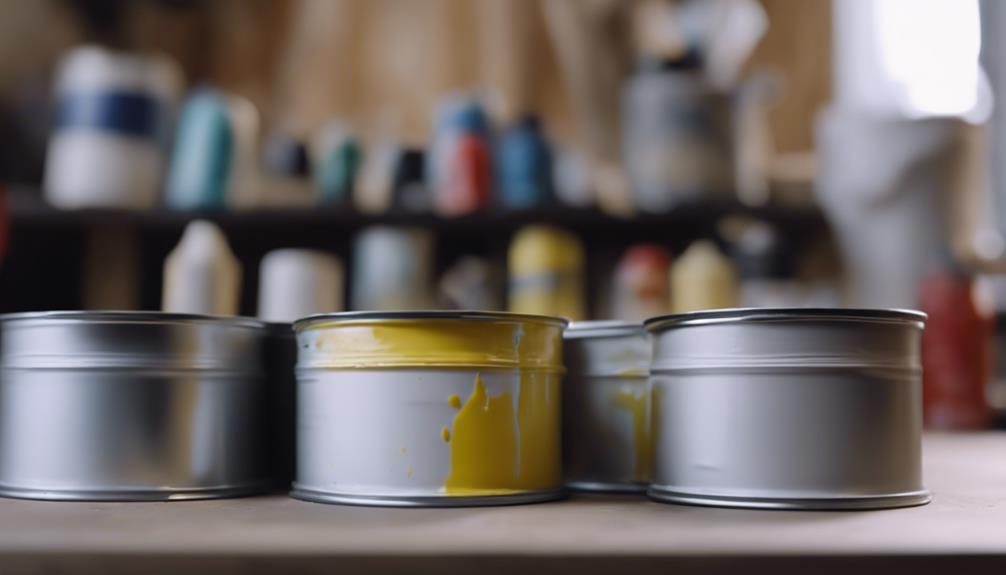
Considering the cost implications, weighing DIY painting against hiring a professional is essential for your interior painting project. DIY interior painting can be as low as $300, offering potential savings, whereas a professional painting company may charge up to $28,000 for a 3,500-square-foot home.
The materials used and the desired quality of the outcome play significant roles in the cost to paint interior spaces. While DIY painting may save money, professional results often yield superior quality but at a higher cost.
When deciding between DIY and professional painting, consider the scope of the project, your skill level, and the desired finish for cost considerations. Keep in mind that the quality of the outcome might vary based on whether you choose to tackle the project yourself or hire a professional painting company.
Additional Cost Considerations
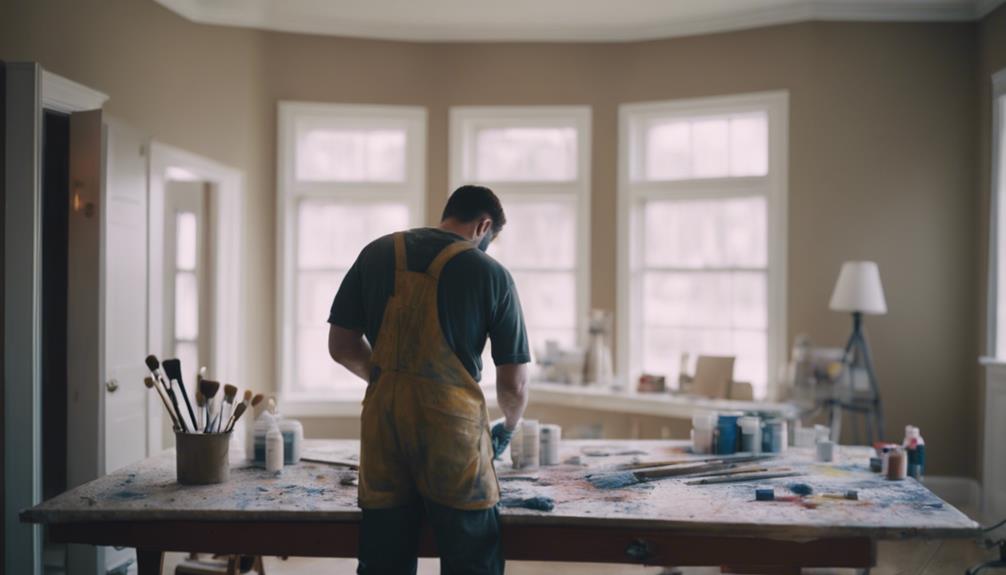
Wondering how certain factors can impact the total cost of painting the interior of your house beyond just the basic services? Here are some additional cost considerations to keep in mind for your painting project:
- Accent Walls: Adding accent walls can increase the budget by 20% to 30% due to the extra work involved in painting them.
- Textured Walls: Textured walls may result in up to a 50% increase in the overall cost of painting the interior due to the additional labor required.
- Wallpaper Removal: Removing wallpaper can cost around $3 per square foot, adding to the total expenses of the job.
- Ceiling Work: Popcorn ceiling removal typically ranges from $1 to $2 per square foot, impacting the total cost of painting the interior depending on the size of the ceilings.
These factors, along with the size of the room, trim work, and any unique architectural features, can all contribute to the total square footage cost of your interior painting project.
Cost to Paint by Square Footage
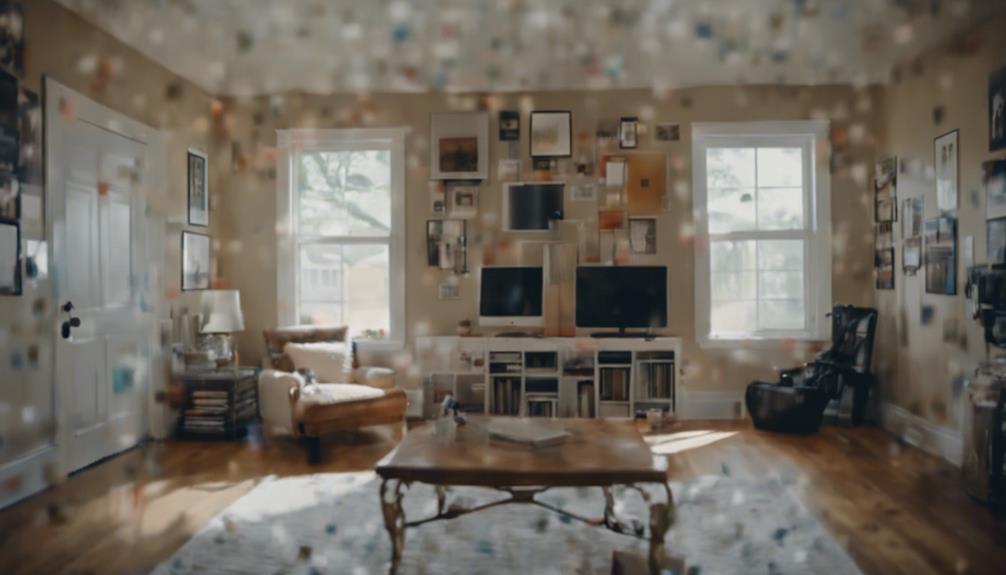
If you're planning to paint the interior of your house, understanding the cost to paint by square footage is crucial for budgeting your project effectively. Interior painting costs typically range from $3 to $7 per square foot. Factors like high ceilings or wall repairs can increase this to $8 or more per square foot.
Different rooms may have varying costs; bedrooms may cost differently than kitchens or bathrooms. For a 1,500-square-foot house, the average cost is around $7,500. Professional painters may charge per square foot or linear foot for specific features, impacting the overall cost.
It's important to estimate the total square footage that needs painting, including any special considerations like high ceilings or extensive wall repairs, to get an accurate cost estimate. Be sure to factor in these variations when planning your budget to guarantee a smooth and cost-effective painting project.
Interior Surface Painting Costs
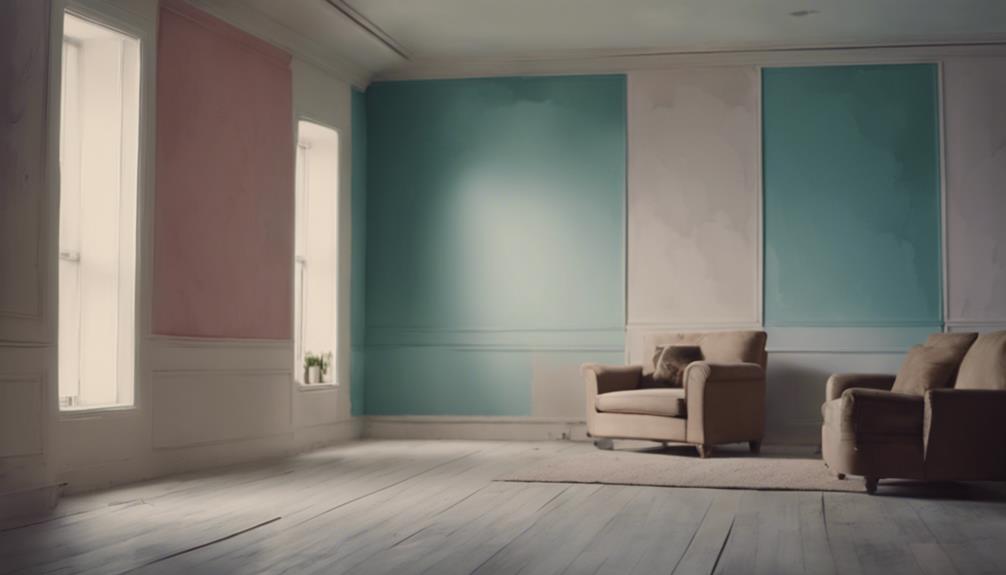
When estimating the cost of painting the interior surfaces of a house, it's essential to factor in varying expenses for wall, ceiling, and trim painting, along with additional costs for doors, cabinets, countertops, and floors. To calculate the total cost effectively, consider the following breakdown:
- Wall Painting: Costs range from $1 to $2 per square foot.
- Ceiling Painting: Typically ranges from $1 to $2 per square foot.
- Trim Painting: Expenses can vary from $1 to $3 per square foot.
- Additional Surfaces: Extra costs may apply for painting doors, cabinets, countertops, and floors.
Cost Savings Tips for Painting
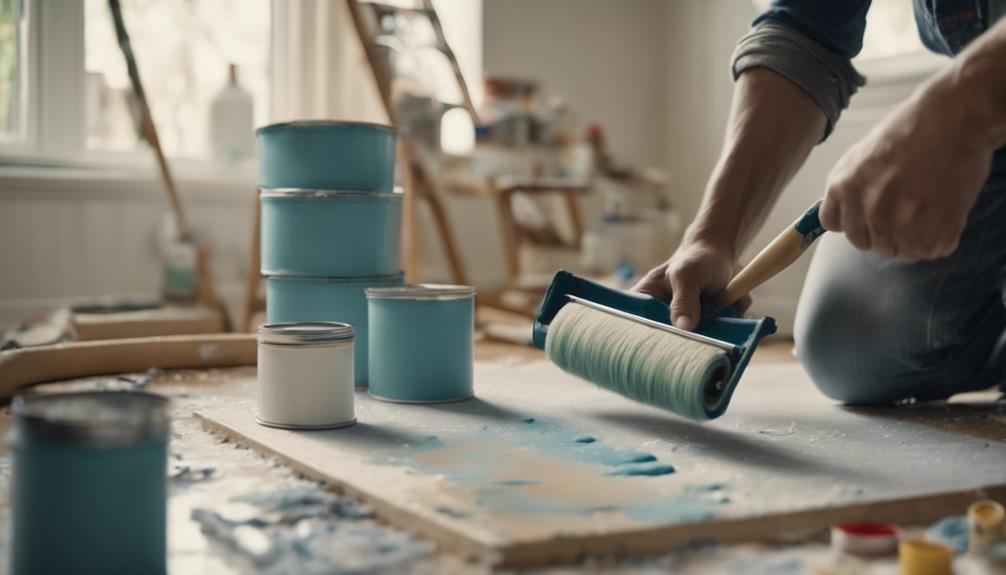
Looking to save on your interior painting project?
Consider painting during the off-season, using low-VOC paints, and ensuring proper ventilation.
These budget-friendly techniques, efficient supplies, and DIY strategies can help you manage costs effectively.
Budget-Friendly Painting Techniques
Consider opting for off-season painting, low-VOC or No-VOC paint products, and DIY techniques to save costs on your interior painting projects. When painting, guarantee proper ventilation to reduce fumes and odors, especially during winter projects. Utilize the Unit Cost Method for accurate estimates and budget management.
Explore DIY painting options for potential savings, but for larger or complex projects, hiring professional painters may be more efficient. By selecting off-season times, eco-friendly paints, and cost-effective methods, you can achieve a budget-friendly interior paint job while maintaining indoor air quality. Remember, proper planning and smart choices lead to both economic and environmental benefits in your painting endeavors.
Efficient Paint Supplies
To achieve cost savings while painting, prioritize investing in high-quality paint brushes and rollers for a smoother finish and reduced need for additional coats. Consider using paint sprayers for larger wall surfaces to save time and guarantee an even application.
Purchase paint in bulk or during sales to reduce the cost per gallon and minimize waste. Invest in essential supplies like painter's tape and drop cloths to protect surfaces and prevent costly mistakes during Home Interior Painting.
Properly clean and maintain your paint brushes and rollers to prolong their lifespan and avoid the need for frequent replacements. By using efficient paint supplies and techniques, you can enhance the quality of your work while keeping the cost estimate under control.
DIY Painting Strategies
When tackling DIY painting projects, essential strategies can help you save on costs while achieving a professional finish. Here are some tips to keep in mind:
- Properly prime walls before painting to guarantee better adhesion and a longer-lasting finish.
- Calculate paint material costs and choose quality paint to enhance the overall result.
- Factor in the cost of supplies and equipment such as brushes, rollers, and ladders when budgeting for your project.
- Careful planning and preparation are vital for achieving a professional-looking finish and cutting down on labor costs, providing potential savings for your DIY painting endeavors.
Finding Local Painters for Hire

You can easily discover local painters for hire by utilizing online platforms like Angie's List, Thumbtack, and HomeAdvisor. These websites provide a convenient way to browse through profiles, read reviews, and compare quotes from different painters in your area.
Asking for referrals from friends, family, or neighbors is another effective method to find reliable local painters who've been tried and tested. Checking with local paint stores or hardware stores can also lead you to reputable professionals they may recommend.
If you prefer a more direct approach, contacting painting contractors in your area and requesting quotes for your interior painting project can help you assess the costs and services offered. Additionally, visiting local painting associations or organizations can provide you with a list of accredited painters available for hire in your community.
Frequently Asked Questions
How to Estimate Labor Cost for Interior Painting?
To estimate labor costs for interior painting, consider factors like room size, surface type, and project complexity. Prep work time, number of coats, and special techniques also impact costs. Professional painters may charge per hour or per square foot. Obtain multiple quotes for comparison.
Labor rates typically range from $20 to $50 per hour. Understanding these factors will help you determine a reasonable labor cost for painting the interior of a house.
What Is the Average Cost to Paint the Inside of a 1500 Square Foot Home?
When painting the inside of a 1500 square foot home, costs typically range from $3,000 to $7,000. This estimate covers painting walls, ceilings, and trim.
Many factors, like wall height and paint quality, can influence the final price. Professional painters often charge between $2.25 to $5.75 per square foot for interior painting.
To get an accurate price, it's best to request an estimate from a professional painter.
How Much Does It Cost to Paint a 12X12 Room and Ceiling?
When painting a 12×12 room and ceiling, costs can range from $400 to $900 due to room height, wall condition, and paint quality. Professionals usually charge $2 to $6 per square foot for interior painting. Additional expenses may include primer, supplies, and any necessary repairs.
While DIY can save money, hiring pros guarantees quality. Factors like prep work and finishing details impact the final price.
How Much Should I Charge to Paint?
When determining your painting charges, consider factors like square footage, room size, and surface type. Additional costs may apply for ceilings, trim, doors, and unique features like accent walls. Other factors impacting pricing include prep work, materials, labor, and location.
Professional painters typically charge between $20 to $50 per hour for interior painting services.
Conclusion
To sum up, when it comes to painting the interior of your house, the cost will vary depending on the size of the room, the quality of paint, and whether you choose to hire a professional or do it yourself.
Remember, 'you get what you pay for' – investing in a skilled painter may result in a higher upfront cost but can save you time and guarantee a quality finish that lasts.
Consider these factors when deciding how much to charge for your painting project.
Mason – Your Product Expert Mason is your go-to product expert, carefully selecting each item in our collection to ensure it meets your comfort, functionality, and style needs. With his attention to detail and commitment to quality, he ensures that every product we offer enhances your home experience.

Wall Art and Decor
How Much Cost to Paint Interior House
Solve the mystery of interior house painting costs starting from $2.75 per square foot – discover what factors influence the final price!
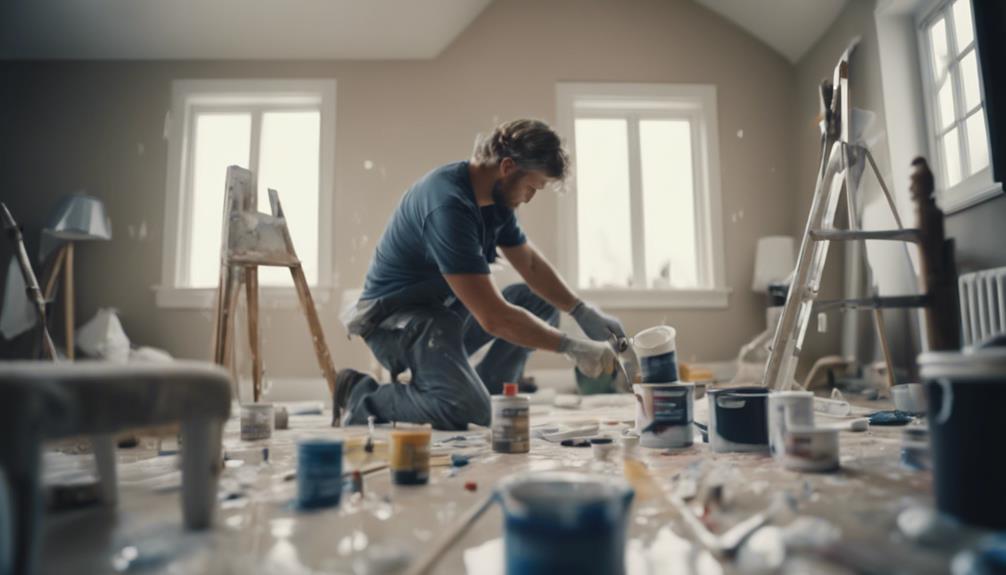
To estimate the cost of painting the inside of your home, anticipate spending between $2.75 and $4.69 per square foot. Factors such as walls, trim, ceilings, and the size of the room all play a role in determining the overall costs. Higher ceilings or detailed trim work can lead to higher expenses. The quality of the paint used and any necessary wall repairs will also impact the final price. Prices for painting bedrooms typically range from $375 to $1,200, while living rooms can vary from $600 to $2,000. Ceilings generally cost between $1 and $2 per square foot, while trim work can range from $1 to $3 per square foot. Taking into account labor costs, paint quality, and the size of the room will help in providing accurate cost estimates. For a more thorough breakdown, consider exploring the various factors that can affect the cost of interior painting.
Key Takeaways
- Interior painting costs vary based on room size, paint quality, and labor rates.
- Factors like wall, trim, and ceiling painting influence overall expenses.
- Professional painters can cost $20 to $50 per hour, potentially saving money.
- DIY painting typically costs $200 to $300 for supplies.
- Quality paint and proper preparation are essential for a durable and aesthetically pleasing finish.
Average Interior Painting Cost Breakdown
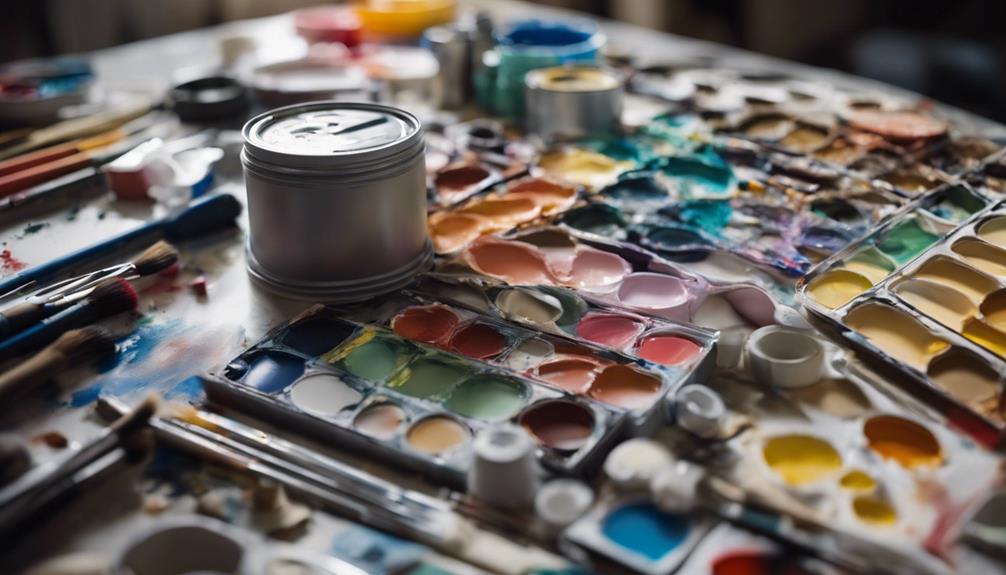
When considering the average cost breakdown of interior painting, it's crucial to factor in various elements such as walls, trim, and ceilings. The cost of painting per square foot for interiors typically ranges around $2.75. However, when including walls, trim, and ceilings, this cost can increase to approximately $4.69 per square foot.
Factors like ceiling height, the intricacy of trim work, and the condition of the surfaces can all influence the final cost of interior painting. Additionally, labor rates, the size of your home, and regional pricing disparities play a significant role in determining the overall expense.
For instance, if your ceilings are higher than standard, expect the cost to be higher due to the additional work required. Furthermore, labor rates can vary, impacting the total cost. Consider these factors when planning for interior painting to establish an accurate budget that reflects the specific needs of your project.
Calculating Interior Painting Expenses
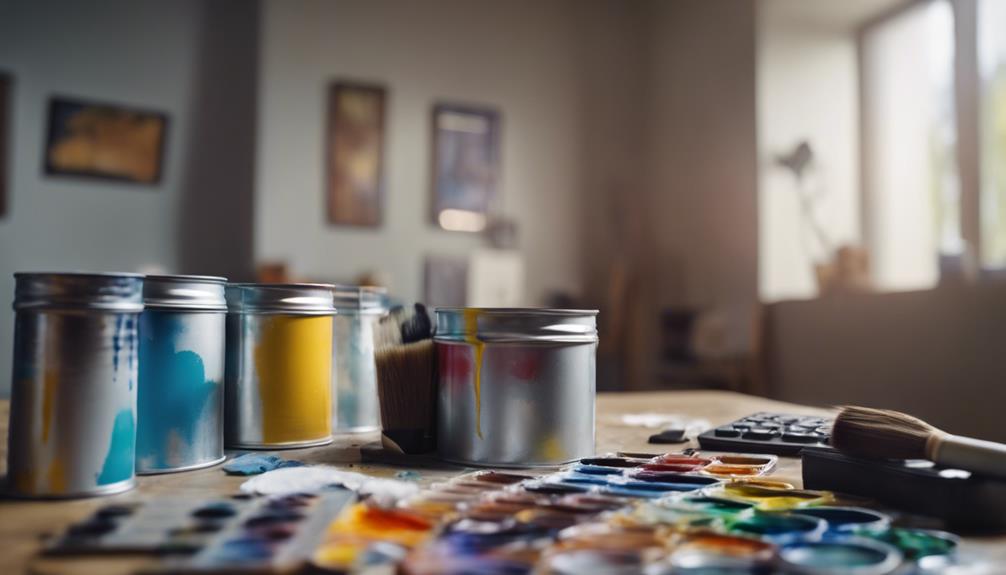
To calculate your interior painting expenses accurately, consider various factors that influence the overall cost. When estimating costs, take into account labor rates, room height, and the extent of wall repairs needed. Additionally, the quality of paint you choose and the ease of access to the painting area will impact your total expenses greatly.
Here are three key points to help you calculate your interior painting costs effectively:
- Labor Rates: Labor costs can vary based on location and the complexity of the job. Get quotes from multiple painters to compare prices.
- Quality Paint: Investing in high-quality paint may seem pricier initially but can save you money in the long run due to better coverage and durability.
- Wall Repair and Priming: Properly preparing your walls by repairing any damages and applying primer can ensure a smoother finish and help the paint last longer. Remember to include these costs in your calculations.
Interior Painting Cost Factors
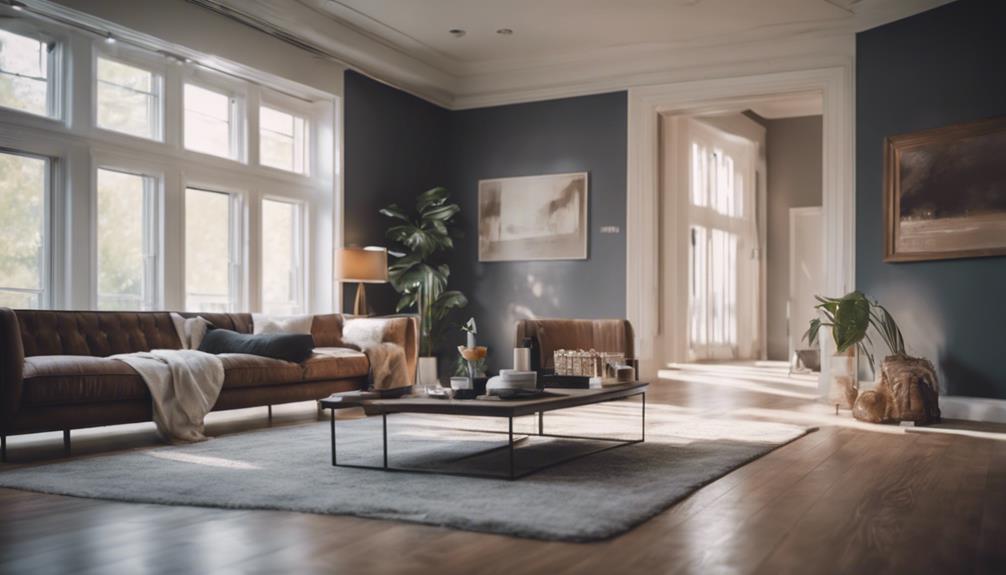
When contemplating the cost to paint your interior house, several key factors can influence the overall expenses.
The type of paint chosen for the project, the size of the rooms being painted, and the varying labor rates are all crucial elements to take into account.
These factors can greatly impact the total cost of your interior painting project, so it's vital to factor them in when planning your budget.
Paint Type Impact
Premium paint types can greatly impact the cost of painting the interior of your house, potentially increasing expenses by $2 to $6 per gallon. When considering paint types for your project, keep in mind the following factors:
- Low-VOC or No-VOC paints can add $20 to $80 per gallon to the overall cost.
- High-quality paint brands like Sherwin-Williams or Benjamin Moore can raise costs by $30 to $70 per gallon.
- Opting for specialty finishes like metallic or textured paints might increase the project cost by $2 to $8 per square foot.
Choosing eco-friendly paints can also lead to a 10% to 20% increase in total painting expenses. Be mindful of these paint type variations as you plan your interior painting budget.
Room Size Factor
Considering room size is important when determining the cost of painting the interior of your house, as it directly impacts the amount of paint and labor required for the project. Costs per square foot may vary based on the size of the room, with larger rooms generally costing more to paint. Larger rooms with higher ceilings can lead to additional expenses due to the increased surface area that needs to be covered.
The dimensions of the room, such as length, width, and height, play an important role in estimating the required paint and labor. Room size plays a key role in influencing the overall cost estimate for interior painting projects, with square footage being a key factor in pricing calculations.
Labor Costs Vary
Labor costs for interior painting projects can vary greatly based on factors such as project complexity, wall height, and prep work involved. When considering labor costs for your interior painting project, keep in mind the following factors:
- Project Complexity: The intricacy of the design or the number of walls to be painted can affect labor costs.
- Wall Height: High ceilings may require special equipment and more time, leading to higher labor costs.
- Prep Work: Extensive prep work, such as filling holes or sanding surfaces, can increase the hours needed for the project, impacting labor costs.
Interior Painting Costs by Room
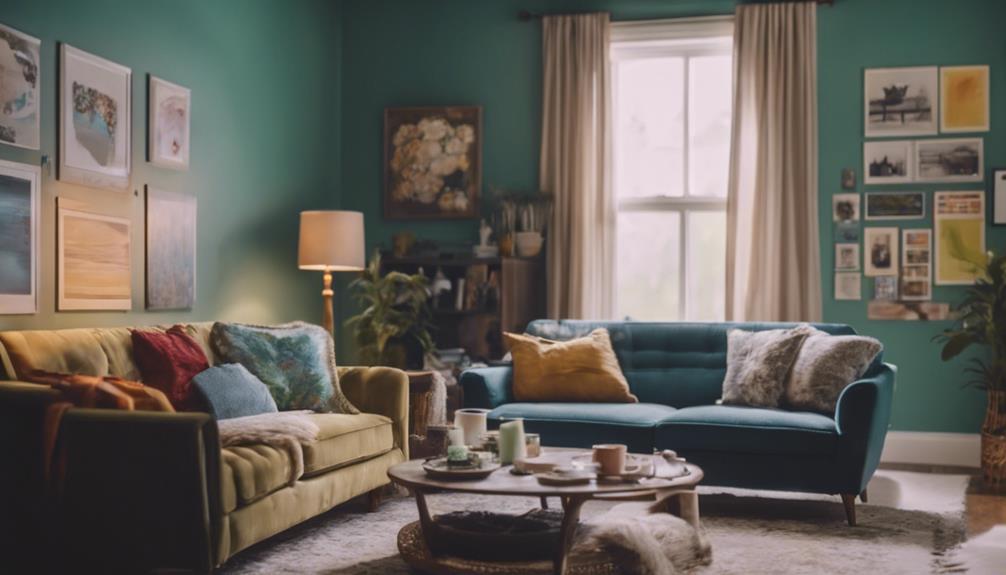
When considering interior painting costs by room, two key points to remember are:
- The impact of room size on the final cost. Larger rooms typically require more paint and labor.
- The quality of paint chosen. It can affect both the price and the longevity of the paint job.
Room Size Impact
To evaluate the impact of room size on interior painting costs, you must take into account the dimensions and intricacies of each space. When it comes to painting different rooms in your house, the size and features play a significant role in determining the overall cost.
Here's how room size impacts painting costs:
- Bedroom: Costs range from $375 to $1,200, influenced by the room's size and complexity.
- Living Room: Prices vary between $600 and $2,000, with factors like trim and ceiling height affecting the total cost.
- Bathroom: Smaller spaces cost around $150 to $400 to paint, but intricate features may increase the expenses.
Consider these factors when planning your interior painting project to guarantee an accurate budget estimation.
Quality of Paint
Investing in high-quality paint for your interior painting project can greatly impact the overall cost, ensuring better coverage and durability. High-quality paint, though pricier initially, can result in long-lasting results. Premium paints often require fewer coats, potentially cutting down on labor costs.
The paint quality you choose can affect the paint coverage, with better paints offering a smoother finish. Additionally, selecting the right paint sheen and type for each room is important, as it can influence both the final appearance of the project and the overall cost.
Cost of Painting Interior Surfaces
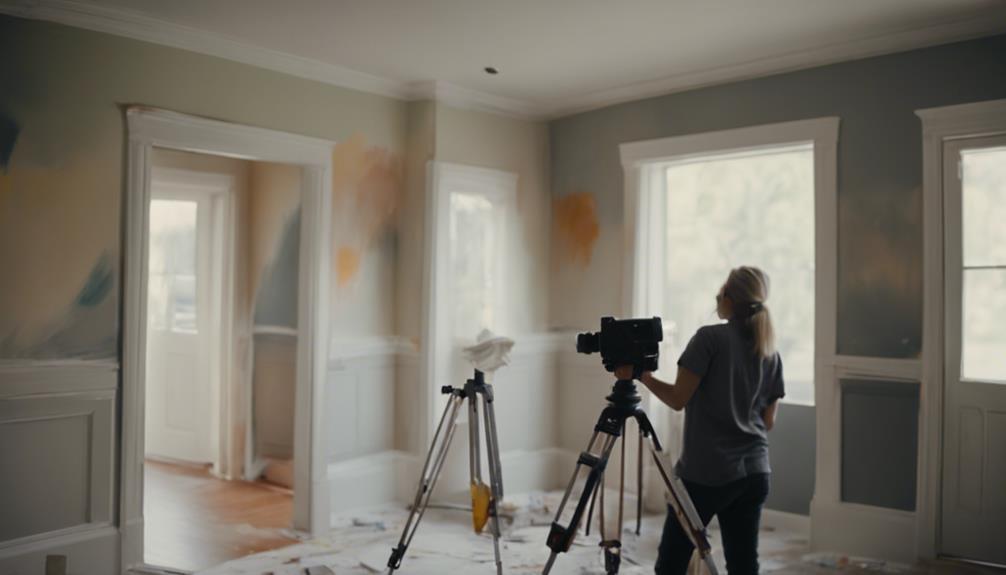
The cost of painting interior surfaces can vary depending on the type of surface and the desired finish. Here are some average costs per square foot for different interior surfaces:
- Walls: Typically, painting walls costs between $1 to $2 per square foot.
- Ceilings: Painting ceilings generally falls in the range of $1 to $2 per square foot.
- Trim: Painting trim ranges from $1 to $3 per square foot.
Additionally, unique features like accent walls can increase your budget by 20% to 30%. If you have textured walls that need to be smoothed out before painting, this process can lead to a 50% increase in painting costs. Consider these factors when planning your interior painting project to make sure you budget accordingly and achieve the desired results within your financial means.
Savings Tips for Interior Painting
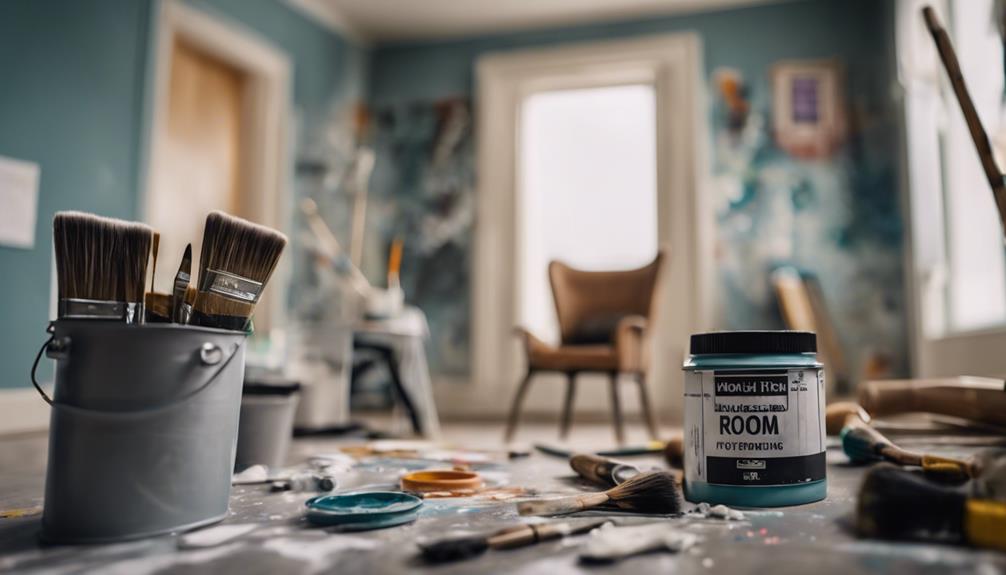
Considering the cost-saving benefits of off-season painting and eco-friendly paint options, explore these practical tips to save on your interior painting project.
Opting for low-VOC paint not only reduces harmful fumes but also lessens the environmental impact. During winter projects, guarantee proper ventilation to minimize fumes and maintain air quality.
Hiring local professional painters ensures quality workmanship and fair pricing. To save on costs, get multiple quotes from different painters and negotiate prices to find the best deal.
Off-season painting, typically from November to February, can help lower expenses due to decreased demand. By implementing these strategies, you can achieve savings while still obtaining high-quality results for your interior painting project.
Hiring a Professional Vs. DIY
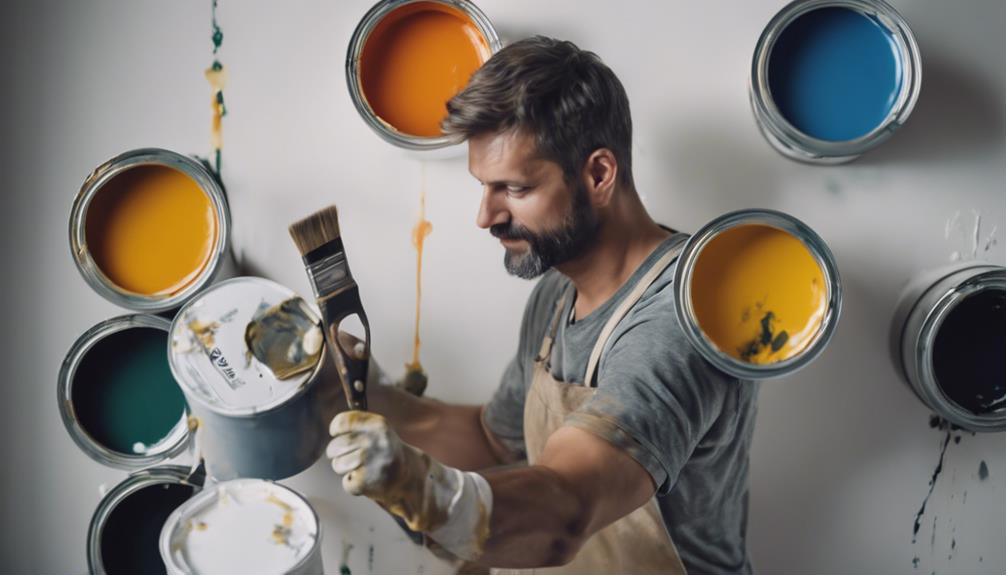
For deciding between hiring a professional painter or tackling the job yourself, evaluate your budget and expertise level before making a choice.
When it comes to painting your interior house, consider the following:
- Costs: Hiring a professional can range from $20 to $50 per hour for labor, while a DIY approach typically costs between $200 and $300 for supplies, potentially saving you money.
- Expertise and Efficiency: Professional painters bring expertise and efficiency to the job, ensuring a high-quality finish that may be challenging to achieve on your own.
- Time and Skill Level: DIY painting requires purchasing materials and investing your time. Consider your skill level and the desired quality of the outcome when deciding whether to hire a professional or do it yourself.
Frequently Asked Questions
What Is the Average Cost to Paint the Inside of a 1500 Square Foot Home?
The average cost to paint the inside of a 1500 square foot home can range from $7,500 to $22,500. Factors like high ceilings, wall repairs, and desired paint quality influence costs. Specific rooms like bedrooms, living rooms, kitchens, dining rooms, and bathrooms can impact prices.
Labor rates, materials, and home size are key cost determinants. Hiring professionals for a 1500 square foot home could cost you between $15,000 to $45,000 depending on various factors.
How Much Paint to Paint the Interior of a 2000 Square Foot House?
To paint the interior of a 2000 square foot house, you may need around 8-10 gallons of paint for just the walls. If you include ceilings and trim, you might require 15-20 gallons. High-quality paint can cost between $25 to $50 per gallon, impacting your total paint expenses.
Labor costs for painting a 2000 square foot house typically range from $2,000 to $6,000. Total costs for painting this size house can vary from $3,000 to $10,000.
What Is the Labor Cost to Paint the Interior of a House?
Labor costs to paint the interior of a house range from $20 to $50 per hour, influenced by project size and complexity. Professional painters may charge hourly or per square foot. Rates vary by region, with cities usually higher.
Skilled painters deliver quality work but increase costs. For a clear estimate, consider factors like room size and desired finish. Hiring professionals guarantees a well-done job, though at a higher price point.
How Much Does It Cost to Paint a 12X12 Room?
To paint a 12×12 room, you can expect to pay between $350 to $850 on average. Factors like room height, wall condition, and paint quality influence the cost. High-end jobs may range from $1,000 to $3,000.
If you opt for a DIY project, materials could cost around $200 to $300. Hiring a professional painter might run $25 to $50 per hour for labor.
Conclusion
To sum up, when it comes to painting the interior of your house, remember the wise saying: 'Measure twice, cut once.'
By carefully calculating costs, considering various factors, and exploring DIY options, you can save money while still achieving the desired results.
Whether you choose to hire a professional or tackle the project yourself, being informed and prepared is key to a successful and cost-effective interior painting experience.
Mason – Your Product Expert Mason is your go-to product expert, carefully selecting each item in our collection to ensure it meets your comfort, functionality, and style needs. With his attention to detail and commitment to quality, he ensures that every product we offer enhances your home experience.
Wall Art and Decor
How Much Cost Paint Interior House
Hovering over the potential costs of painting the interior of your house? Find out why factors like materials, labor, and quality play a crucial role in determining the final price.
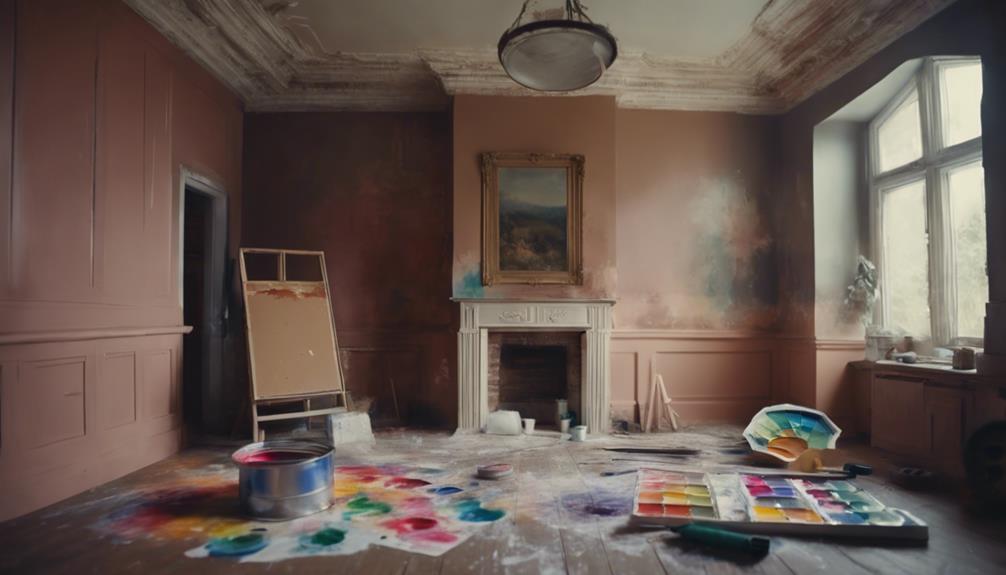
To paint the interior of your home, the average cost is $2.75 per square foot. If you include walls, trim, and ceilings, it may rise to about $4.69 per square foot. Factors like room height and needed repairs impact the final cost. Materials like paint range from $15 to $60 per gallon. Labor costs vary from $20 to $50 per hour. Different paint types and quality levels affect pricing. Remember, obtaining multiple quotes can aid in comparing costs effectively. Understanding these elements will help you make informed decisions about painting expenses.
Key Takeaways
- Average cost: Interior painting averages $2.75 per sq ft.
- Cost factors: Factors include materials, labor, and repairs.
- Labor expenses: Labor costs vary based on skill and complexity.
- DIY option: DIY painting can save on labor costs.
- Material costs: Quality paints range from $15 to $60 per gallon.
Interior Painting Costs Overview
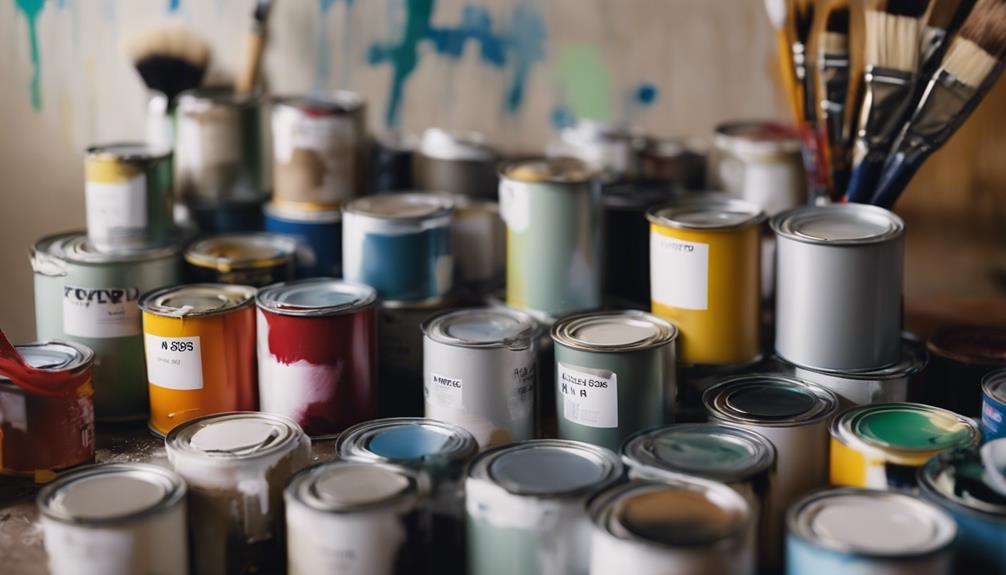
When considering the cost of painting the interior of your house, it's important to understand the factors that contribute to the overall expenses. The average cost of interior painting is approximately $2.75 per square foot.
However, if you include painting walls, trim, and ceilings, this average can rise to around $4.69 per square foot. Factors such as the height of the room and ease of access can affect the overall cost of the interior painting job.
Labor rates, materials used, and the size of your home are key elements that influence the total cost of the project. It's worth noting that opting for off-season painting, typically between November and February, can potentially save you money on your interior painting project.
Cost Factors for Interior Painting
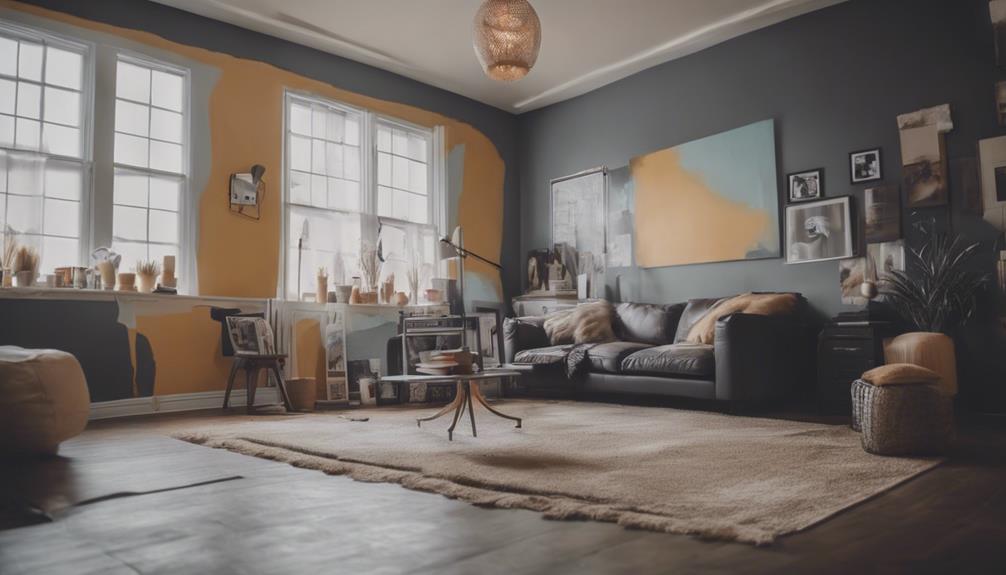
When calculating the cost of painting the interior of your house, it's important to take into account the breakdown of material expenses, estimate labor costs, and determine your total project budget. Material costs include paints, primers, brushes, and other supplies, while labor expenses cover the payment for professional painters who'll complete the job.
Material Costs Breakdown
To break down the material costs for interior painting, consider the varying prices of paint types ranging from $15 to $60 per gallon based on quality and type. Different paint options like oil-based, water-based, and latex come with different price points. When calculating paint costs, take into account the coverage area and the number of coats required for the job.
Additionally, equipment and supplies such as brushes, rollers, paint trays, and tools can range from $3 to $300, impacting the overall expenses. Opting for quality materials and excellent craftsmanship may incur higher costs but can result in a more durable and aesthetically pleasing finish.
Choose the paint type and materials that align with your budget and desired outcome for your interior painting project.
Labor Expenses Estimation
Taking into account the significance of labor expenses in interior painting projects, it's crucial to factor in the typical range of labor costs, which usually fall between $20 to $50 per hour. Professional painters determine charges based on square footage or linear foot, especially for features like high ceilings.
Factors such as project complexity and wall repair can also impact labor costs. To guarantee you get the best deal, obtaining multiple quotes from professional painters is recommended. This allows you to compare labor expenses effectively.
Total Project Budget
For an interior painting project, understanding the total project budget involves carefully evaluating the various cost factors at play. To determine the total project cost, consider:
- Cost per Square Foot: Interior house painting typically ranges from $3 to $7 per square foot, depending on factors like project size and paint quality.
- Labor Costs: Labor expenses vary from $20 to $50 per hour, impacting the overall budget greatly; hiring a professional painter can guarantee quality results.
- Multiple Quotes: Obtaining quotes from different painters for comparison is advisable to make cost-effective choices and ensure fair pricing for your interior painting project. Remember, investing in quality paint is important for a successful outcome.
Painting Costs by Square Footage
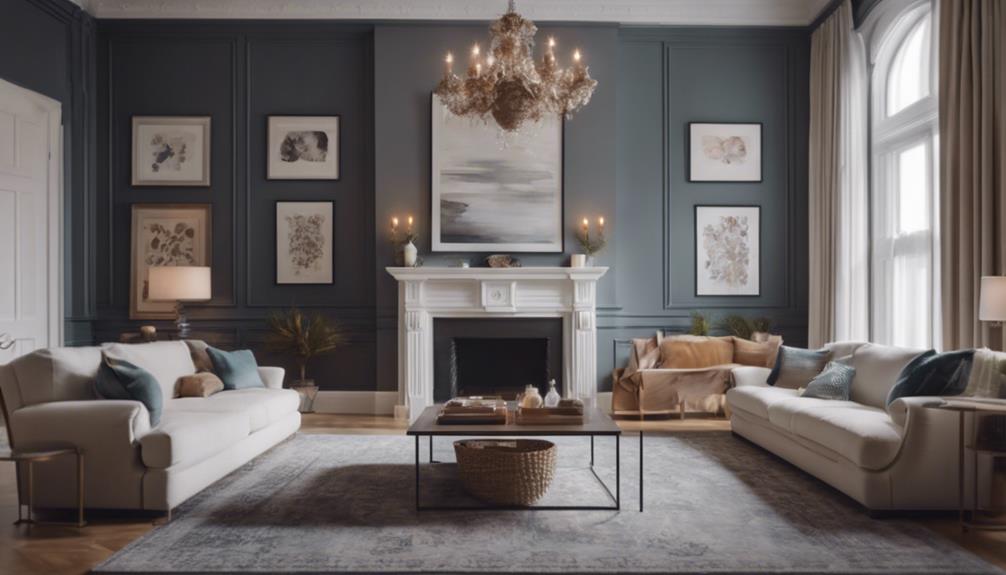
When estimating painting costs based on square footage, consider the average rate of $2.75 per square foot for interior house painting. This price per square foot can vary based on factors such as room height, the inclusion of trim and ceilings, market variations, and the size of the home.
Factors like room height, ease of access, and necessary repairs before painting can also influence the total cost. Including walls, trim, and ceilings in the painting project can increase the cost to $4.69 per square foot. Market variations exist between different regions, affecting the overall price for interior house painting.
Factors such as home size, layout, and wall height play a significant role in determining the cost of painting per square foot. Keep these factors in mind when planning your interior painting project to establish an accurate budget.
Labor Expenses for Interior Painting
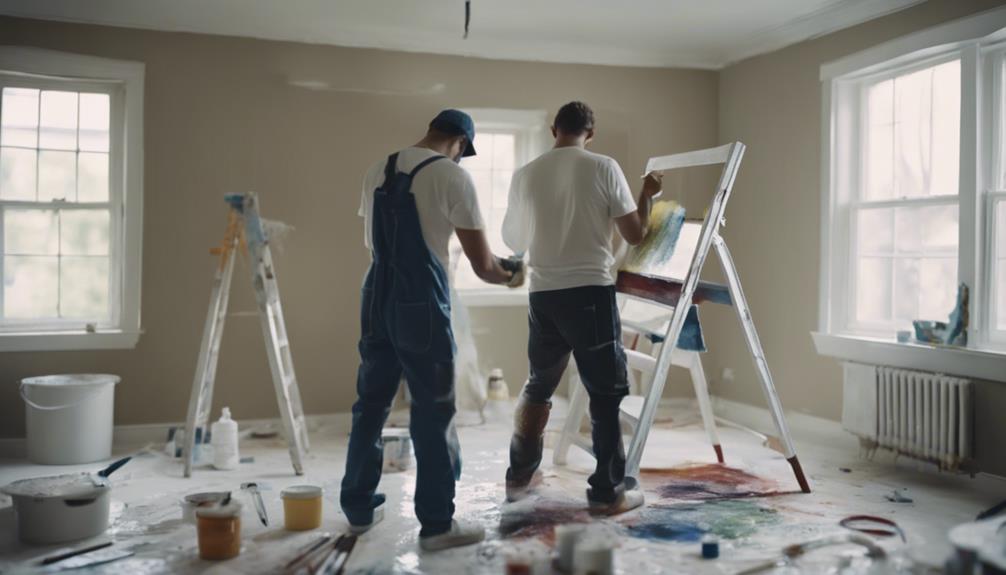
Labor costs for interior painting can vary based on the painter's skill level, impacting the overall pricing of the project.
The time required for completion also plays a significant role in determining labor expenses for interior painting jobs.
Factors like complexity, detailing, and the need for multiple coats can influence the final cost.
Skill Level Affects Costs
Skill level greatly influences the costs of interior painting, with labor expenses varying based on the painter's expertise. When considering hiring a painter for your interior project, keep in mind the following:
- Efficiency: Highly skilled painters work more efficiently, potentially reducing the total hours needed for the project.
- Quality: Experienced painters deliver a professional finish with attention to detail, ensuring a high-quality result.
- Upfront Cost: While skilled professionals may charge higher rates initially, the investment often pays off in the form of a polished and lasting interior paint job.
Choosing a painter with the right skill level can impact both the outcome of the project and the overall cost involved.
Time Required Influences Pricing
The total labor expenses for interior painting are greatly influenced by the time required to complete various painting tasks. Labor costs typically range from $20 to $50 per hour, depending on the complexity of the project and the intricacy of the details involved.
More complex projects or those with intricate details may require additional time, thereby increasing the total expenses. The efficiency and experience of painters also play an important role in determining the overall labor costs. Experienced painters can often complete tasks more quickly and effectively, potentially reducing the total time needed for the job.
Proper planning and organization are essential to minimize labor expenses for interior painting projects.
DIY Interior Painting Cost Breakdown
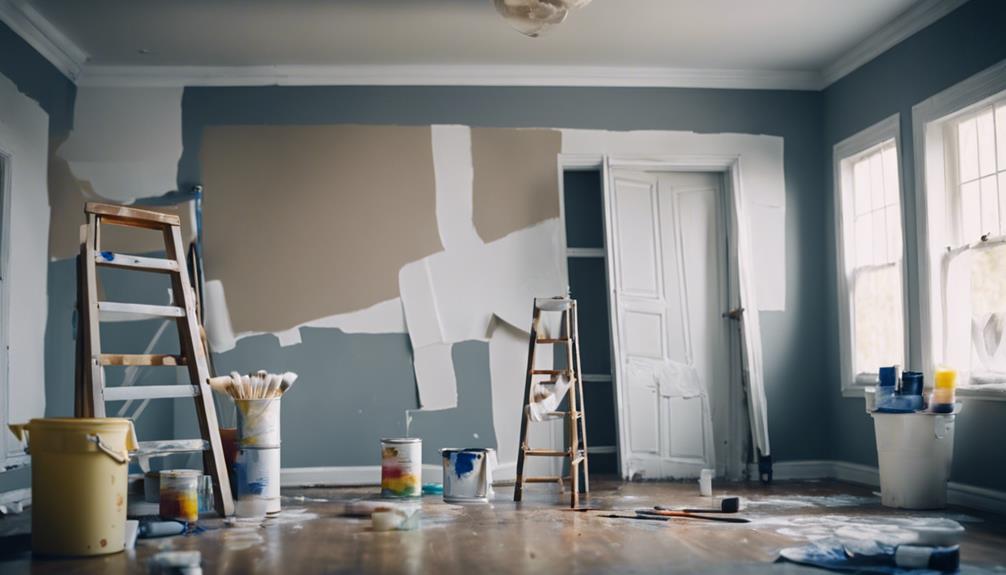
Exploring the breakdown of costs for DIY interior painting can provide valuable insights for budget-conscious homeowners. To help you understand the expenses involved in painting your home, here is a cost breakdown:
- Materials: Purchasing items like high-quality paint, primer, rollers, brushes, painters tape, and drop cloths is essential. These materials typically cost between $100 and $150.
- Prep Work: Tasks such as filling holes, sanding surfaces, and applying painters tape are important for achieving a professional finish. Budget around $50 for these prep work materials.
- Labor Costs: Since you're doing the painting yourself, you'll save on labor expenses. However, keep in mind that dedicating time and effort to the project is valuable, and the cost regarding time shouldn't be overlooked.
Interior Paint Material Costs
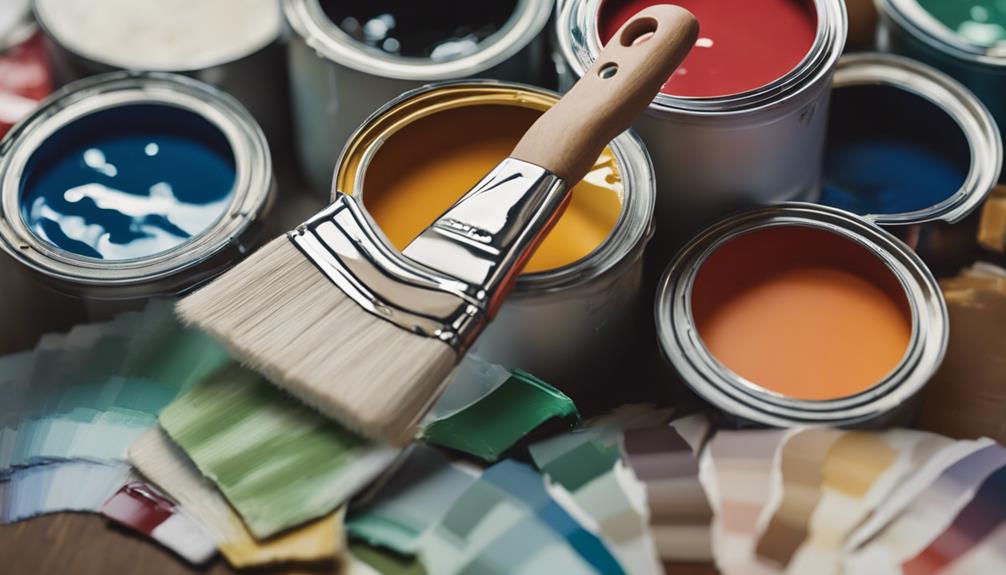
When painting the interior of your house, the cost of materials plays a significant role in your overall budget. Interior paint costs can range from $15 to $60 per gallon, depending on the quality and brand you choose. Opting for higher quality paints typically falls within the $30 to $60 per gallon range. Calculating paint costs involves considering factors such as coverage area and the number of coats needed to achieve the desired finish.
Different types of paint, including oil-based, water-based, and latex, come at varying price points, affecting your material costs. In addition to paint, you must also account for paint supplies like brushes, rollers, trays, and tools, which can range from $3 to $300, further contributing to the overall expenses of your interior paint job. Choose your paint colors wisely and take into consideration the quality of the paint brands to ensure a satisfactory outcome.
Additional Factors Affecting Costs
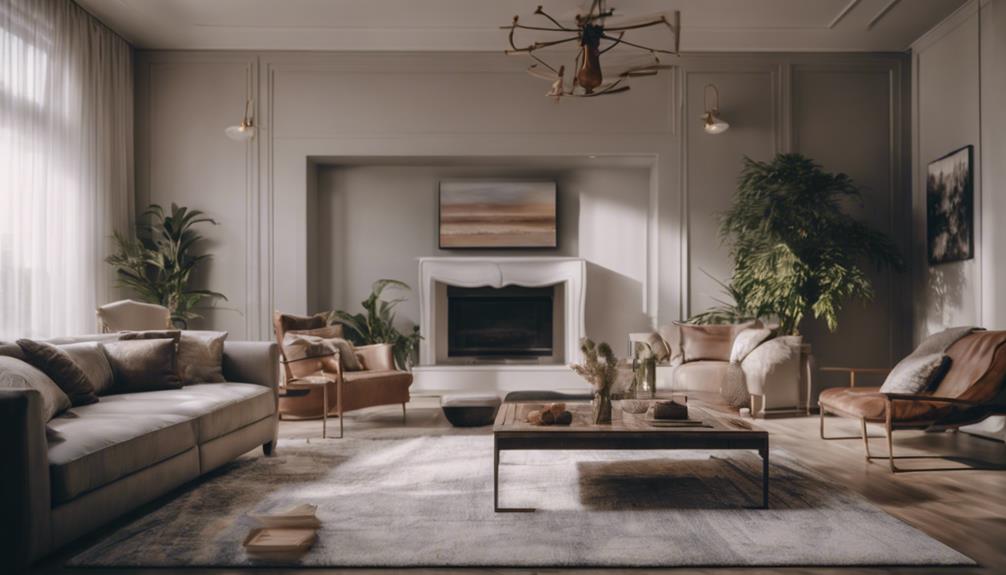
Considering the various factors influencing the cost of painting the interior of your house, it's important to also address additional elements that can impact your overall expenses. Here are some key factors to keep in mind:
- Labor Rates: Labor rates typically range from $20 to $50 per hour, so the amount you spend on labor can greatly affect your total expenses.
- High Ceilings, Wall Repair, and Accent Walls: Factors like high ceilings, extensive wall repair, or the addition of accent walls can increase your interior painting costs due to the extra time and materials required.
- Size of the Home and Materials Used: The size of your home, along with the materials used such as paint quality and finishes, play an important role in determining the overall price of the project. Additionally, local market rates for labor and materials can vary, impacting the total cost of painting your house's interior.
Be mindful of these factors to better estimate your interior painting expenses.
Cost Considerations by Housing Type
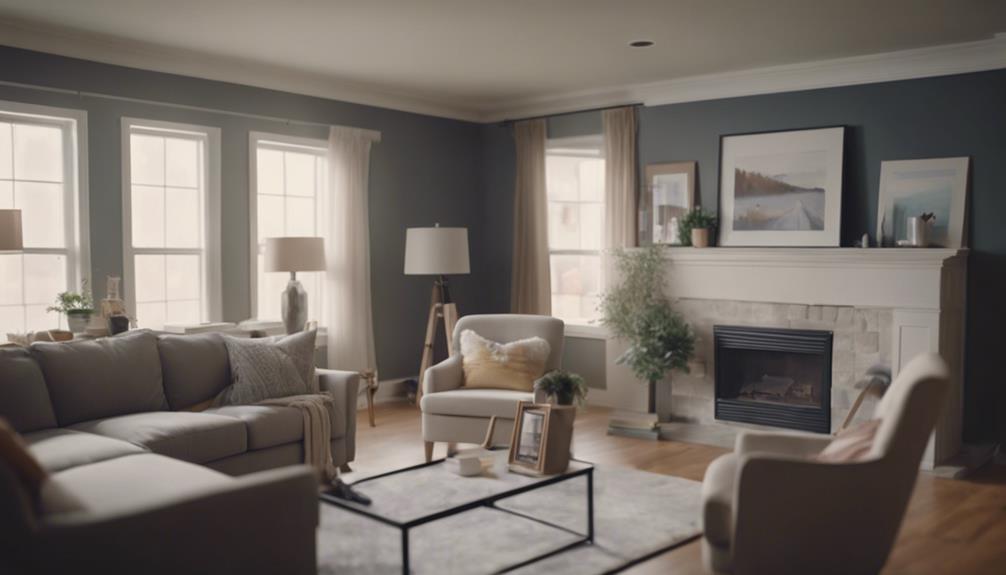
The cost considerations for different housing types when painting their interiors vary greatly. When painting an apartment, the cost typically ranges from $2,150 to $4,600. For a condo, you can expect to pay between $2,400 and $5,800.
Common areas in buildings like hallways or lobbies may have varying costs depending on their size. Specific rooms such as bedrooms, living rooms, bathrooms, and kitchens may also incur different painting costs. When painting interior surfaces like walls, ceilings, trim, and interior doors, there are specific cost considerations to keep in mind.
Older houses might require more preparation work, potentially increasing the overall cost. To get a rough estimate of how much should it cost to paint the interior of a house, consider factors like the size of the area, the quality of the paint product, and whether you hire professional house painters.
Cost-Saving Strategies for Interior Painting
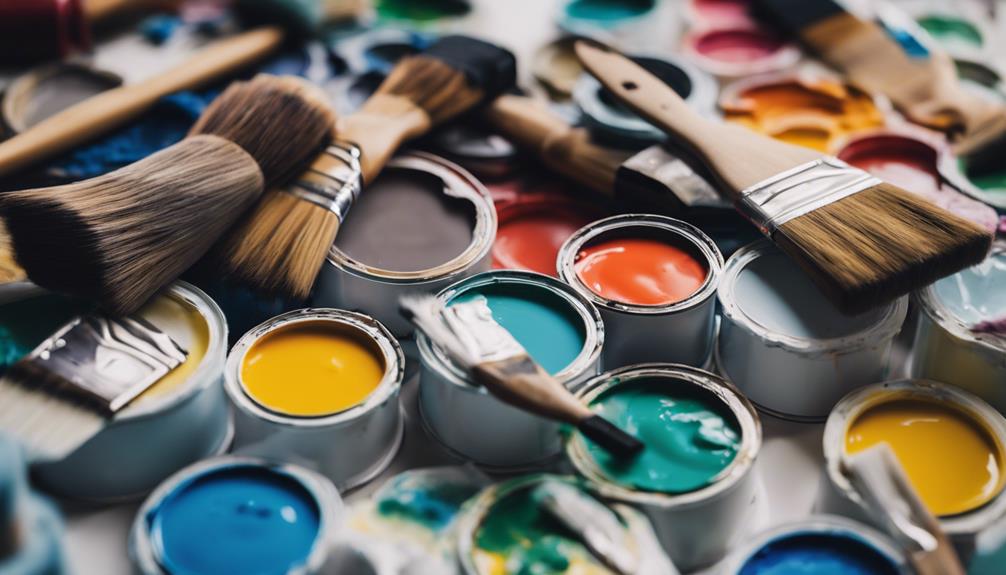
To save costs on interior painting, explore utilizing off-season painting times and opting for low-VOC or No-VOC paint products to reduce harmful fumes. Here are three cost-saving strategies to contemplate when painting the interior of your home:
- Choose Off-Season Painting: Painting during off-peak months like November to February can lead to cost savings due to lower demand for painters.
- Opt for Low-VOC Paint: Selecting paint with low-VOC or No-VOC levels can't only be eco-friendly but also reduce the unpleasant odors often associated with painting.
- DIY vs. Hiring a Professional: Ponder whether you have the skills and time to paint yourself, as DIY projects can save you money compared to hiring a professional.
Frequently Asked Questions
How Much Should I Charge to Paint the Inside of a House?
When determining how much to charge for painting the inside of a house, take into account factors like the size of the rooms, layout, and any additional repairs needed. Room dimensions, wall height, and complexity affect costs. Professional painters typically charge per square foot or linear foot for walls, ceilings, trim, and doors.
Quality of paint, labor rates, and project intricacy also impact pricing. Make sure your rates cover materials, labor, and any extra expenses for a detailed quote.
How Much Paint to Paint the Interior of a 2000 Square Foot House?
To paint the interior of a 2000 square foot house, you might need around 8-10 gallons of paint for walls only. Including ceilings and trim could increase this to 15-20 gallons. Factors like paint quality, surface texture, and colors can affect the amount needed.
High ceilings or extra rooms may also increase the total required paint. Calculating accurately helps in budgeting for your project.
How Much Does It Cost to Paint a 12X12 Room?
To paint a 12×12 room, you can expect to pay between $300 and $800, depending on factors like paint quality and additional services. This cost covers labor, materials, and prep work such as cleaning, sanding, and priming.
Prices may vary by location, with urban areas typically being more expensive. Adding trim, ceilings, or accent walls can bump up the total cost. Consider getting quotes from different painters to find the best deal.
How Much Does It Cost to Paint a 400 Square Foot House Interior?
To paint a 400 square foot house interior, consider factors like paint quality, prep work, and labor rates. Prices may vary based on room count, ceilings, and trim. DIY painting can save money, but experts guarantee quality. Get multiple quotes to find the best price. Costs range from $1,100 to $2,800.
Hiring professionals guarantees a professional finish, while doing it yourself can cut expenses, but may require more effort and time.
Conclusion
To sum up, understanding the cost of painting the interior of your house is essential for budget planning. Factors like square footage, labor, materials, and housing type all play a role in determining the overall cost.
By grasping these cost factors and considering DIY options or cost-saving strategies, you can better prepare for your interior painting project.
Remember, a well-informed approach can help you achieve the desired look for your home without breaking the bank.
Mason – Your Product Expert Mason is your go-to product expert, carefully selecting each item in our collection to ensure it meets your comfort, functionality, and style needs. With his attention to detail and commitment to quality, he ensures that every product we offer enhances your home experience.
Wall Art and Decor
How Much Cost Paint Interior Door
Pondering the price of painting your interior door?
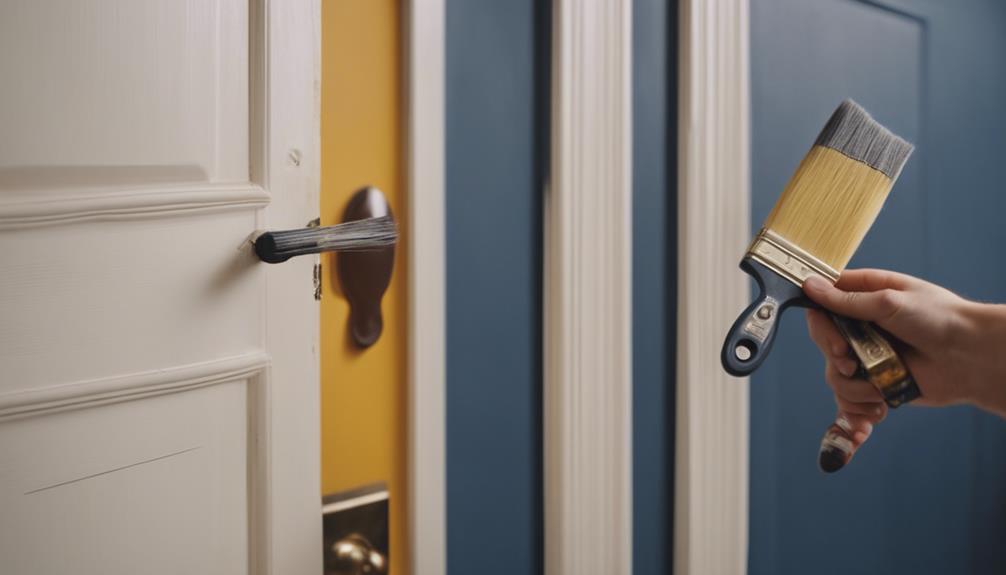
When painting your interior door, take into account factors such as size, type, and finish. Labor costs can vary, and different paint types and finishes are available at different prices. The size of the door will impact the materials and labor required; for example, French doors can be more expensive. Certain finishes may require specialized paint or techniques. Consider the door’s size, type, and material when estimating costs accurately. You can explore cost-saving tips like painting multiple doors together or choosing simpler designs. Understanding these factors will help you better plan for the total cost of painting your interior door.
Key Takeaways
- Door size, type, and material influence painting costs.
- Labor expenses range from $20 to $50 per hour.
- Different paint types and finishes have varying prices.
- Opt for cost-effective choices like single colors and simple designs.
- Proper preparation ensures a durable finish and cost savings.
Factors Affecting Interior Door Painting Costs
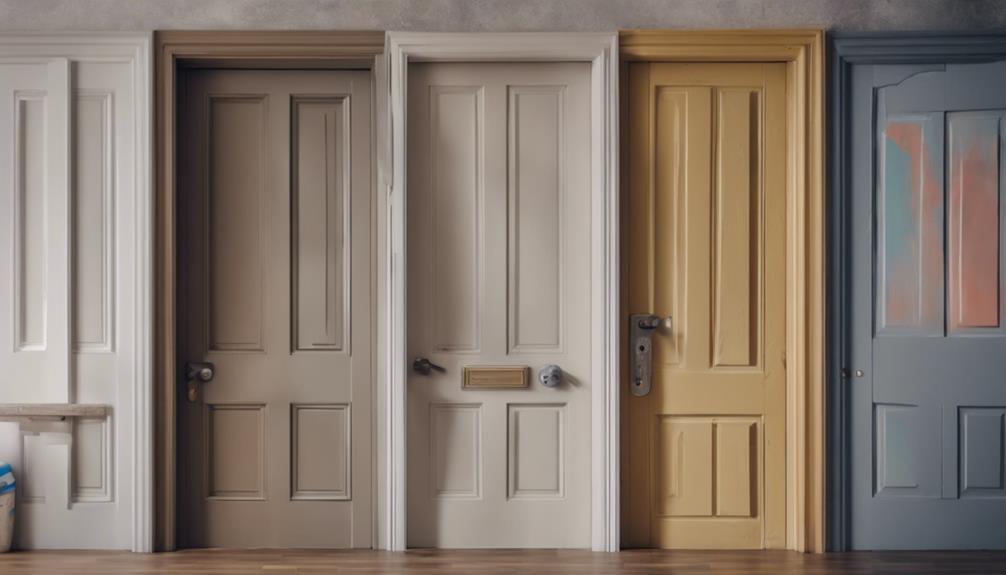
When determining the cost of painting an interior door, various factors significantly influence the overall painting expenses. The size of the door plays an important role in determining the amount of materials needed for the project, which in turn affects the total cost. Larger doors require more paint and additional labor, raising the overall price.
The type of door also impacts the cost, with French doors typically costing more to paint due to their intricate design compared to simpler bifold doors. Additionally, the finish of the door, whether it requires a more specialized paint or technique, can increase the painting expenses. Different types of paint and finishes come with varying price points, affecting the overall cost of the project.
Labor costs also play a significant role in the total cost of painting an interior door, as the complexity of the job and the time required influence the final price.
Average Cost for Different Door Types
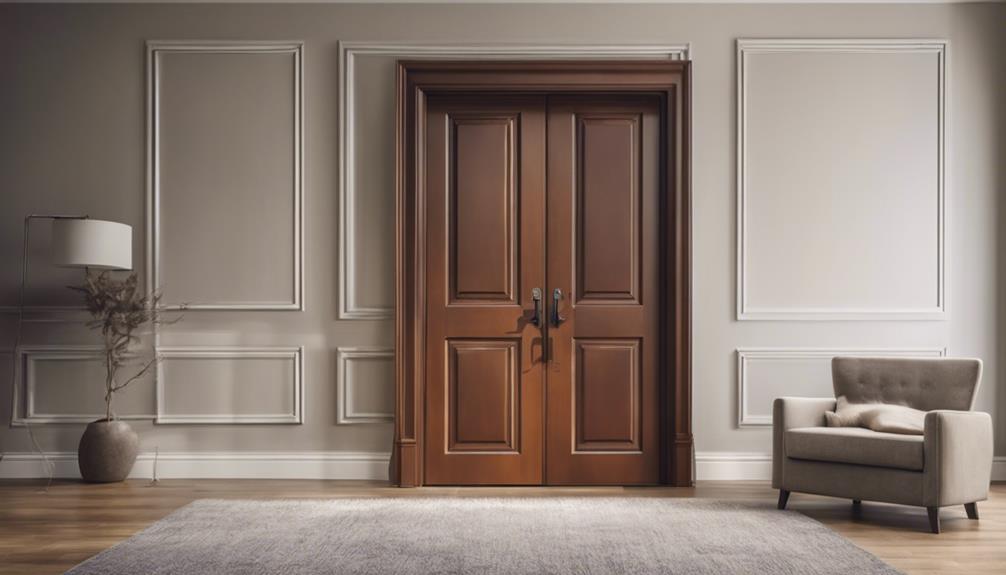
The average cost of painting different types of interior doors varies depending on the size and design complexity. For smaller doors like a 24 x 80, painting can range from $25 to $75. If you have a slightly larger door, such as a 28 x 80, expect to pay between $40 and $100 for painting. Moving up in size to a 32 x 80 door, the cost typically falls between $50 and $200. Larger doors like a 36 x 90 can have painting costs ranging from $100 to $300.
When it comes to different door types, such as bifold doors, 6-panel doors, sliding doors, and louvered doors, the painting cost varies based on the size and intricacy of the design. Each type may have a different cost range, so it's crucial to take into account the specific dimensions and style of your interior door before estimating the painting expenses.
Material Specific Painting Costs
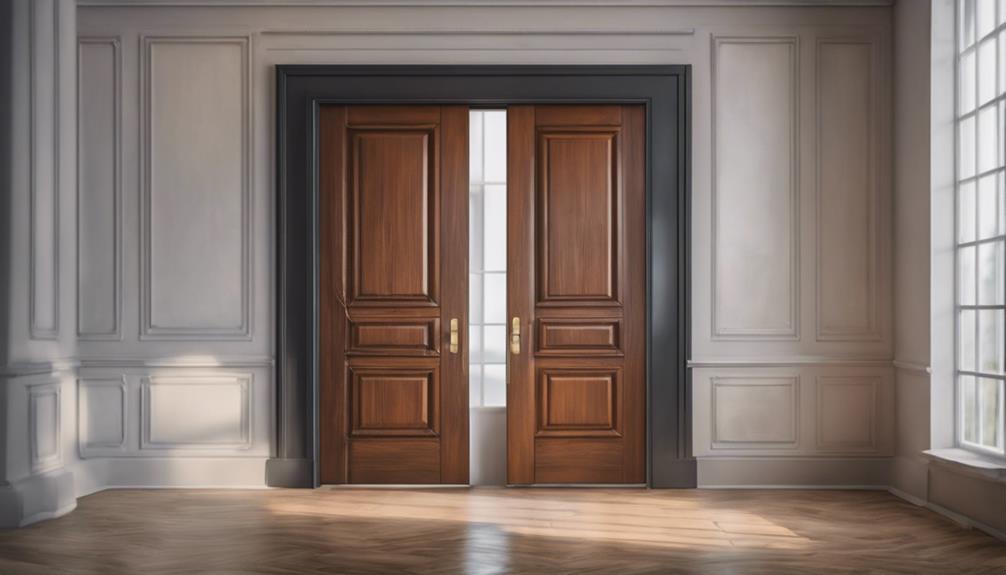
To accurately estimate the cost of painting your interior door, consider the specific painting expenses associated with the material used and the type of paint selected. Different door materials such as MDF, vinyl, composite, metal, wood, and fiberglass have varying painting costs depending on factors like surface condition and the type of paint you choose. For instance, using a water-based primer on MDF doors might be more cost-effective compared to applying high-quality paint on a metal door due to differing surface absorption rates. Oil-based products are often more expensive than water-based options but may be necessary for certain materials. Below is a table outlining how material choice and paint type can impact painting costs:
| Material | Recommended Paint Type | Additional Cost Considerations |
|---|---|---|
| MDF | Water-based primer | Surface condition |
| Vinyl | High-quality paint | Type of paint finish |
| Metal | Oil-based products | Primer requirements |
| Wood | High-quality paint | Sealant needs |
| Fiberglass | Water-based primer | Surface preparation |
Paint Type and Finish Pricing
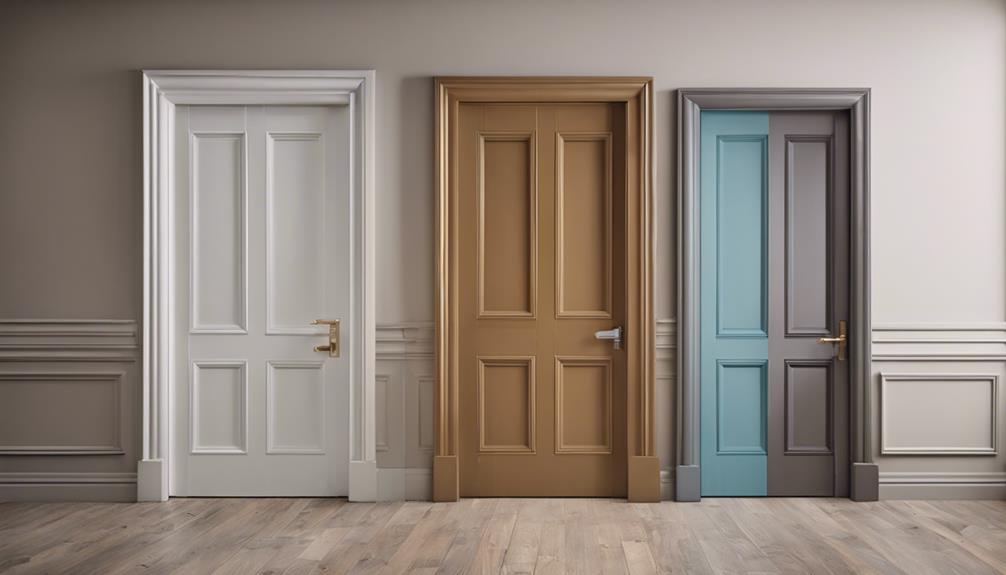
When considering painting your interior door, keep in mind that different paint types and finishes can affect the overall cost. Water-based, oil-based, and chalk paints have varying prices per gallon.
Finishes like matte, eggshell, and high-gloss also come with specific cost considerations. Understanding the price ranges for different paint types and finishes is essential in planning the budget for your interior door painting project.
Paint Type Options
Considering the various paint type options available for interior doors, you can explore a range of finishes and pricing to suit your desired look and budget.
Water-based paint, ranging from $15 to $40 per gallon, offers a budget-friendly choice. Oil-based paint, priced between $20 and $60 per gallon, provides a durable and traditional option. If you prefer a trendy and versatile look, chalk paint could be a great choice at $25 to $50 per gallon.
Matte finish paint, ranging from $15 to $40 per gallon, gives a subtle and elegant appearance. For a modern and sophisticated touch, high-gloss paint priced at $30 to $60 per gallon offers a shiny and reflective finish.
Each type caters to different styles and preferences, allowing you to select the best fit for your interior doors.
Impact of Finish
Exploring the impact of different finishes on your interior door painting project reveals how the choice of paint type and finish pricing directly influences the overall aesthetics and durability of the painted surface.
Finish options such as matte, eggshell, satin, semi-gloss, and high-gloss come with varied cost per gallon, ranging from $15 to $60. Opting for a semi-gloss finish, for instance, may increase the overall cost but provides a more durable and glossy look compared to matte options.
The selection of a specific finish not only affects the aesthetic appeal of your interior door but also plays an important role in determining its longevity. Understanding the impact of finish choices on cost and quality is essential for achieving the desired outcome in your interior door painting project.
Labor Costs and Additional Services
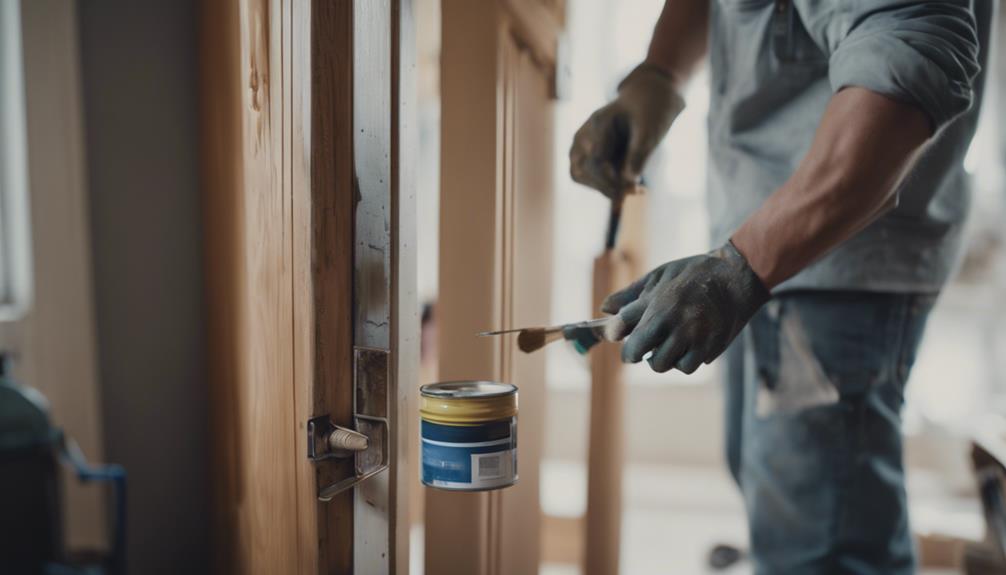
To calculate the total cost of painting an interior door, factor in labor costs and any additional services that may be required. Labor costs for painting an interior door typically range from $20 to $50 per hour, with the average total cost falling between $75 to $150.
Professional painters may charge more for intricate designs or custom work, impacting the overall cost. Additionally, if you need the trim, frame, or jambs painted along with the door, this can also increase the total cost. Labor expenses usually make up a significant portion, around 50% to 70%, of the total cost of painting an interior door.
Keep in mind that the complexity of the job, such as custom work or intricate designs, can influence the final price. Be sure to discuss all your requirements with the painter to get an accurate estimate that includes labor and any additional services you may need.
Tips for Cost-Effective Door Painting
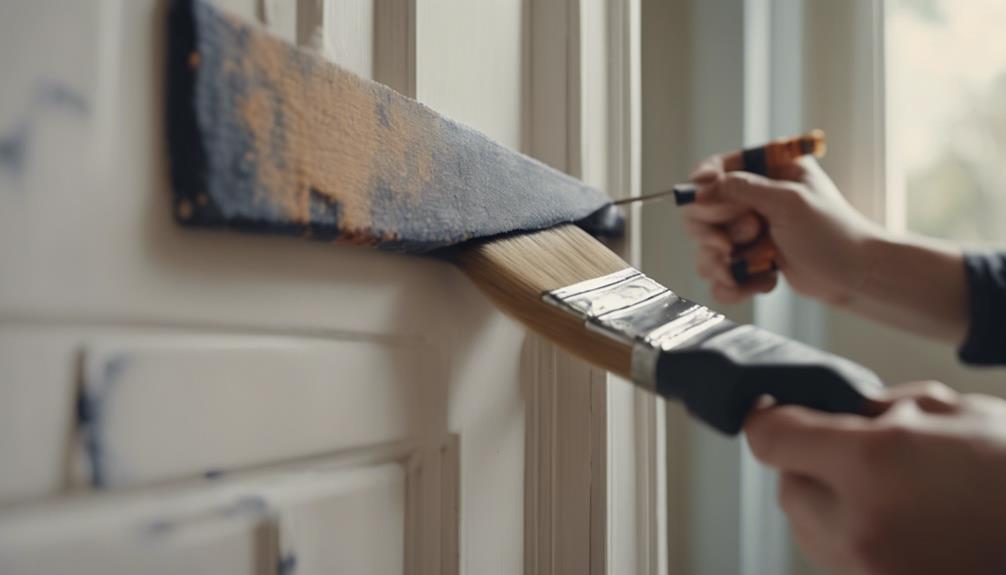
For a more budget-friendly approach to painting your interior doors, consider these cost-effective tips. When planning your project, aim to paint multiple doors at once to benefit from lower average costs per door. Opt for simple door designs like flat-panel doors to streamline the painting process and reduce expenses.
Choosing a single color or minimizing color changes can also help you save on overall painting costs. If you're undertaking a larger home improvement project, include door painting to leverage cost savings on labor and materials. Prioritize proper preparation by lightly sanding the doors and using high-quality paint and primer for a durable finish.
Frequently Asked Questions
How Much Does It Cost to Have an Interior Door Painted?
To have an interior door painted, the cost generally ranges from $75 to $150. This price includes both the materials and labor needed for both sides of the door. If you're painting French doors, it can cost between $200 to $400.
For bifold doors, the cost typically falls between $75 to $150. Labor costs by professionals range from $20 to $50 per hour, with door paint prices ranging from $15 to $60 per gallon.
How Much Does It Cost to Have an Internal Door Painted?
To paint an internal door, the cost typically ranges from $75 to $150. This includes both materials and labor. Door paint prices can vary from $15 to $60 per gallon for interior doors. Labor costs by professionals can range from $20 to $50 per hour.
For complex doors like French doors, the cost may increase to around $200 to $400. Painting kitchen cabinet doors can be pricier, ranging from $900 to $3,800 depending on size and material.
How Much Paint for an Interior Door?
To paint an interior door, you typically need about 1 to 2 gallons of paint. Factors like door material, size, texture, and color can affect the amount required. Professional painters often use this range for standard doors. Consult with a painting expert for accurate estimates based on your door's specifics.
Consider budgeting between $15 to $60 per gallon for paint. Choose wisely to guarantee a smooth and durable finish.
Is It Worth Painting Interior Doors?
Painting interior doors can be worth it for a fresh look. It can enhance your home's overall appearance without breaking the bank.
Consider DIY for cost savings, but hiring a professional guarantees a polished finish. The price varies based on door type and complexity, so weigh the cost against the desired outcome.
Ultimately, a freshly painted door can revitalize your space and add a touch of style.
Conclusion
So, when it comes to painting your interior doors, remember that costs can vary depending on factors like door type, materials, paint type, finish, labor, and additional services.
To keep your expenses in check, consider these tips: choose cost-effective materials, do some of the work yourself, and shop around for the best deals.
With a little planning and savvy decision-making, you can give your doors a fresh new look without breaking the bank.
Mason – Your Product Expert Mason is your go-to product expert, carefully selecting each item in our collection to ensure it meets your comfort, functionality, and style needs. With his attention to detail and commitment to quality, he ensures that every product we offer enhances your home experience.
-

 Vetted8 months ago
Vetted8 months ago15 Best EMS Foot Massagers for Neuropathy to Soothe Your Feet
-
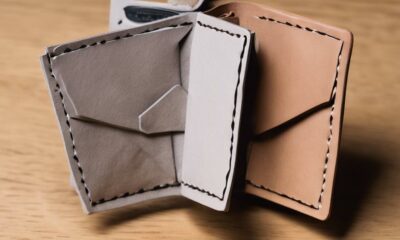
 Vetted7 months ago
Vetted7 months ago14 Best Personalized Father's Day Gifts for Your Husband – Show Him You Care
-

 Alfresco7 months ago
Alfresco7 months agoAlfresco Stacker Doors: Seamless Indoor-Outdoor Living!
-

 Tableware and Dining Accessories2 weeks ago
Tableware and Dining Accessories2 weeks agoWhat Is the Meaning of the Word Tableware
-

 Tableware and Dining Accessories2 weeks ago
Tableware and Dining Accessories2 weeks agoWhen Is Tableware on Sale at Hobby Lobby
-

 Tableware and Dining Accessories2 weeks ago
Tableware and Dining Accessories2 weeks agoWhich of the Following Is Not Classified as Tableware
-

 Vetted2 days ago
Vetted2 days ago15 Best Detergents for Wool: Keep Your Woolens Looking Fresh and Fabulous
-

 Vetted2 months ago
Vetted2 months ago15 Best Home Water Filtration Systems of 2025: A Comprehensive Comparison Guide




